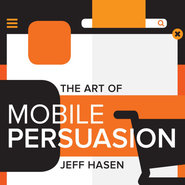By Jeff Hasen
For my new book, "The Art of Mobile Persuasion," I visited some of the brightest minds in mobile, marketing and business, seeking answers to the toughest questions facing marketers in the mobile era.
Among the big issues tackled by Google, Coca-Cola Co., REI, ESPN, Lowe’s, Expedia, Lord & Taylor, are those cited below.
If consumers invite us into their mobile lives, how are we brands to operate? Standing in the doorway like strangers hawking wares from door to door? Or like old friends who put their feet on the furniture and stay all night?
How do we handle user expectations?
I have never, ever had a meatball sandwich from your quick-service restaurant, but you, Meatball Marketer, should know from my purchase history that my diet is vegetarian. So why am I still getting those darn meatball ads?
What about the customer journey? If I am looking at an Armani tie online tonight, should you target me tomorrow when I am near Nordstrom? What is personal and what is creepy?
How does the ever-increasing “self-sufficient” mobile shopper force us to re-shape our definition of differentiated customer service?
What is the role of today’s marketer? Are we replaceable by mechanized data parses and auto-targeting?
 Jeff Hasen
Jeff Hasen
The book was built on their discoveries. The insights gleaned and lessons learned are for all of us who have mobile-fueled aspirations to bring a brand closer to the customer.
Here is some of what came out of the discussions:
Some see the signals, others are not even looking
I just passed my 10th anniversary in mobile.
My entry came when my then employer made a company-wide bet on mobile content in the pre-iPhone and Android days.
To me, mobile marketing today is a no-brainer given the time spent on the devices by our customers and prospects. Others have yet to come around to that thinking.
“Where we are with marketers?” Google’s Jason Spero, vice president of performance media, said to me, repeating my question.
“There are different points of the crawl, walk, run continuum,” he said. “Many marketers are working on the most basic mobile experiences. The first generation of mobile experiences was cut-and-paste desktop experiences with smaller weight images. No video, no Flash.
“Where we’ve gotten to: [some] marketers have come to understand that I want a different experience when I’m on this”—he holds up a mobile device—“than when I’m on this.”
Mr. Spero points to a personal computer.
“Now you’ve built a mobile-specific experience if you are any good,” he said.
“You start to ask questions about signals. You start to be able to say, ‘How do I – the wireless user – want that mobile experience to change if I’m within a mile of a Pizza Hut and am looking for pizza?’ Marketers are trying to find which of those signals are relevant.”
Many marketers collect data, clueless to its use
Much like the ill-advised race in 2007 to build an iPhone application, many marketers have taken on Big Data more to check a box than to get closer to a business outcome.
Wise mobile marketers know better.
“There needs to be a specific need that benefits the customer,” Jonathan Stephen, who drove innovative mobile programs at JetBlue Airways, told me for The Art of Mobile Persuasion. “We should not be selfish in our endeavors to reach customers. I think we get very greedy with Big Data.
“If possible, we want to know what our customer had for breakfast,” he said. “We want to know how many sugars that they put in their coffee and if they used Splenda or Truvia or whatever. There’s this grasp for data, and the funny thing is people [marketers] find out that they don’t even know what to do with that data.”
Mobile enables desire
Longtime ad man Hank Wasiak told me that mobile enables marketers to deliver on advertising pioneer Bill Bernbach’s goal of persuasion.
A terrific example is Coca-Cola, one of the world’s most recognizable, beloved and successful brands that is fulfilling its long-established mission in an increasingly large part through the use of wireless devices.
“Our mobile strategy was really articulated in the 1920s when Robert Woodruff described the role of The Coca-Cola Company as putting our brands within the arm’s reach of desire,” Tom Daly, group director of mobile and search, told me. “The only thing that is different today is that at the end of that arm, between it and desire, is a mobile device.
“To the degree that strategy is a choice, the choice that we are making is to have mobile enable desire,” he said. “The alternative is to do nothing and have mobile become a barrier. That doesn’t sound smart.”
Jeff Hasen is founder/president of mobile consultancy Gotta Mobilize, Seattle. Reach him at [email protected]. His latest book is “The Art of Mobile Persuasion” (Frontier Press, June 2015).
{"ct":"cog3pXuUZ6sT\/IZnJWehpmh+N0fKxIMa8uTM+iWbeVm\/8y5UUUy8EHmgohTs2urIvZXG\/qgWy4ZWwX35qhi+d2sOrBqbhwEonBe4C2Fj2zKcel917DlVs7ZLfqlbLU2JPzMaMdwEG1G\/QvAx9ShIZGG5MX1eYa8TzHOVZZD8vbd8RfOn46mu7NOd2I79pz9TE9++eBsr6worEnAOsiuq\/1v8KNT7mI+oHcsvjE+XMO20E8D4nAzqqJn5ZjFD9\/9gpPWe3edwAEHPL46MJaKCRmcDmVw5JpchRBAYB7gwD\/ZSSE1sOEgaxh\/GEbTRoI5PBmN7jvoFYlCZbJuRtFb0r+8YQtmmGZR+79IEeIanfZ84PQRqKRt+socLy+1paPkf18xzAq3r2X\/EXRvG3kcDc9LGrrFiTfCbYDnk2JMjfepZEC6+fRB9TsTmuazDs8Zz1\/1dAARlzrzLXMM6EawOiRbVdNR6IMr3WBeyzQIvmj1EB4Tiy47I84WbN0\/IhnFo3F7gTzbd9J3G47G5hE869Kk\/sxv3JzHF9fEwXfgu8Lny8znFguCJpyhyuc5p8\/s9zw5lxdX+vre5\/C5n6CAwVSyrFXh7m6EV5XlLLAfzKjMT8DBAb4OdMEuwAAdNVfzFQ4k1ZnOXP2LwCFDPHjuizSWW2CH505WbsmEEx7rvS13+BKgs\/Qr2VV+Q+yUlXpuL1HlOCUxTVoPYQhZGZkjs1rWbDqNUitO851BwwriX41s1mrlO4UjgTYidHdtKPC9wjLDwOPXBHRuuNNkDmA3qyjqqNk6jWy+bjDSejQvC3PueJOwUq6WoYT\/s8u1Yrb6XFlaHD3p09LFZkR0H1XXMuq3D8UwjloCg4VJe5OzLqcXLmR6HJYLfxe\/6vP4shX9\/Ak\/m\/n6g33+ChTRL2gp3fpVcfQaM6yxdxCT9XubgyO\/3a+FTwP\/3MmmCB5ByclC4laleHkbtWDba5HnLN9aheRyJIDHDjRaps1vUrqb\/A1TyJMcpCpakR652fybPIsrIGYNz\/z8z8HapdeLyMLW\/hRKjVOeAcFdvFpk2IZsUQ6Oz6EYb+srpsW926nZ3Z53d7TjTu4Enbh2+MaLypTir6oz6KVUgMFDAkQKSeGIMBnD7NnK9CHkjTm8BlSq\/XNAZE0c8O3PfcRaxSUuydng7+o\/c9FfoYPW2wd0DN4HZDoQjcFJLYUKTwf9JYmIlVRjxGkUAtZDEwe9W7Lizau6Sim8AXugEbc4dDCxOTSk8j987kKlHN+ZfoniX9O2eXebjk93kuTzG3ZHOyi\/FjfNEgaVH7pNnOZZB8kkFSIAUQ+ago5\/HVgsP6tJ3Aw03qQXYNB1WLMZHusW379PaKjfOg3i4I8oJpBgAsxWkpyb\/5mkQtCZ5pJ80akC6nmddvt1SomnKBpdfvTHOCAtXH44ak\/fKKc2wEKyaXp5fMjCOoXoS8xqynB2KKzfCKN+qzRrzHUAmw6LeFY2KfnlGsv9VFNHVmoPM90nq+eday+75idiPZql\/5Qx6GPwl\/45H+WQ8TxY50w907dBah1fZx58+rzC3UrSEQz81tIY9f+XStYC4fkdvXaCQz7hReVWf54S+HWndkf0gVdP1dOwASrlIzsxqwXkMSr3F\/iPzr7VFke1G6o+mz9X0SaLAwTCklGZvm\/Qu6vjIMUOUzXgI8TDZf4lGPTHwk+ppLgWnd7+DxO+1z5JpwtIwqkt+LqlPyiFKUT4RlEAk5SWbs4MA4Hy03KHlFsIFxkmqZvIIOy6kf+q1G0xyWJ4usriKWoYbXwoejet1dxUN5AaDEsflh6wyF4fXOP6FvAU5Yf1xu38GKSmBX6ZEoCuCgznDJIuuMX5S5ZLxFeL2G6F8D0tVd3a3CcObpFW4uzAeOOJ1V8MNIX7NiBEplyEMryKHy3jXMmNw4dFLHKj4vjPhlZ1Wl+xbc2FHHAmjyOpl8dcHItLqEoxddpz+etNUiDIKbg1lAovIkwX2ZF1jF\/SdpY5rFT8\/2Mv4sFJV3RH2wxYJn9cdGs7tTkRAr1CtIKo0ioRcAFcc43ACvSEuNkl3Uyif5hNdGTFl4PB9TfyfUStQlzUtRee9QTPNWDOFUvEEjJxV4vO7IwTBrJQCardMDTYwQ0EeaqB5NtfnlEQ3JCtEhliEWqIk3PG5PzpTJnXQWOc0lMUs9R7JPdzDRn0DPgS38KCzAsPMGUWT2PKYjf1FUheRX3KVBz2EP21+UL8AWepzg6XR9ja0Hgr0UXbZRLu6k8R1ijEV3BnIURRwqWfewuLrXFROT4ZzRlBaBKNSvPeGL7drp2JhNgbusftuzX1TYVDJgvSgO\/x6ImBJYbu+5VgEZfJaye6lRWIakF9zZKfjZXKa+J\/l5\/fB5QyrF0Fyif5gHlcWU2Y8T5tdfNZx2dm1UM940kXbggOxcaX4ic73zUVZLOj+QQXxm\/3Ryqx6vWpCC2+CBfOJrI2Jj4NQv84u4x4pWcess3eNMmPt1ZtqjTp85zLKOTWCiDutEcYaWJPgKnlSEQBhnVCHvY\/iCCga0\/3\/tBocMQOCGdq8x3DztejIIPmQ+AO1Rw3B4Qk8aQ7lqtW6dv5+DXnKW9Enu3GhK2iadC6E7T3HgmjTQ1Ynqhg4qZ+soOx3RRE+5OUKNveqai151J\/GafMN3fasnULpnspL3S9fHgJE40\/NR20m8kFm4oV9v+7lU3tTzVFHc+7HcEmhk1o4yrfrh5GKbaKD5vcLzgohb7lDDinuwQPjE9C0Hoy3vwnejDDIAVzGtIKgGzUL7hW5ZHcgbXEXCWhE6wugPlODvPFmbMfitZGRJGdkgtzYvxUjeDtEc21Ljsn5jDaUTcHyyxqAYv27gicfVjCdSBCGSxzt5cZTJ6qrM\/E52FaZj\/MSiSI0ejv0ltQutKz\/gkunbJGVnu0jUbleVV5YNGgmGh07Myz391d\/B6vJFNuzG60h0uZKsYnZ55epbJDDxSkQlE3ZFbSDTV4XfiTBBhAUfDW5z1FkBZU3C796qscakoNx2WM4uTLkDq9T3rpjXis7yaFq8iecExg9xcT5RSbehfqjfwErPuf7p+EdJwJJ203pIugqJrM5z1wgq07LeW8oSriOSoM3LJBS+qrRvHn5wx+2iK04YUalyxqa\/KX8TDVbz71Jhu9FDJyghtY4bQhnI26X4N0QD\/BbsJYmHe4eRw7WfziRE3qWhC2sTrrXSCeeqlGXfrcClMOQmrnN8jdiIgUphRubIvyaqNxa21A6\/zITvTaqisy6HkZCGjL3LEmdZEluhu0jL4nsbiAWmQ2yfP8M4ba64Z9n\/FV2iVkuA3rKFpQgyXM8liGGvTbDg9z07f12rt+IJWRcPzCUZemqVoB5KZ43BLAjPNSiIEqeM998I0tC1NSJ35JF02ysPOoxaxH1epjBTsoi8BeTN01Nj1mV0EhBeNeFZ0UPyKdUZnw1wjayqNooVESu0a9WRdcqNwPXGKqszUeRVCELF59TP80wwRHD34xag1vVJo74DyhGZqJNzqj04XBtnua45qKZvi7hYZcB31\/u\/tav5TFjy\/vhGfzlu1h\/mNmXnTitxL+5yee\/aucNjzExKQiesTaIiFvMKprzyjDYBG5iubQo1xc9YVH2lo3fF8U1Q6\/dEMJj5OGGUcxps5fnAn9Eu4MAfKxOzxcUaMkrjF0DsrcaGx18CnCDgZry0Js2DpuJ+INfusJMMBhvpBe+1F8z9PER18AqNW51eeWy18LnNwGIczQzDXw\/L2IwPlmKdlbAGagDnTehKNkuwHfsU4dF+SjMAEgp0c8n6RRNOnwT\/DvgCLwrucUnOmnj3xKkv1FRsmNkGznfCjHQihy6nyqkrjqYXi5k4PIQ+yBTEAELKo282jCx92eCFBwj5h00Du9xy7gjpvDRTn\/h4MgAoPYqBMkkt2kSNm3v0IxvXSHu5Hz3fPnyOnmUCrDlzqeg68HnqQTYLJHexr9gqdaCNr1dp60N0NPmTyYjH+zNy4TNzEqilajKK0qlkTzL\/6Z6EeStfl\/6n0Gv\/tKd4HMEzX8be1Fr2ioZipPNDYUy+jJum\/v5EO\/OgfG9AK5dyBUwd1ugv4w+LQBau9eZmL\/4CFiu0yi6tTVaSpBaQHzTAeHZYMLvNWwnofm+LCgimBXZ2qj1vvOOw0rQyWpVYShchzASm9n+f+Jj9b8I2+FG+XasgSyCbVsOL+4f8XnRx2MnHX3QiS+5rmVTooolLhm6BFiGh0ip2SfH2EUkTEG+9axkHiHeR086OxK7Sjn1b9I7XrvsA3QHrNyxEOqSph4wFG3+ebkjNuLLCAXUh+THP4YFdz\/rxjiO9H1S5G4YE7dH0+MQPeBKYBRz7ykzUsuNoM5VfLZC0VwBghDr5AGL7TtkkFKnLDrZ1PO4blwYLrnsFjqiLf0NLJ+gjkeGBdksGYfp9gpcwhTLg1zmxS5rBrmU19gljCamo20wvO76I8dt6vP3eE8gcWO1OYonNnO3wPPP17u0sTYViKKaq3Irxva2Ty5FGQNBuAvzm2GXgAnRUuU0sms9vGZJfuGA8az\/sYMBCn6Lgy5nW\/Sj7r7mHI1KL4hOWorerDNjn\/rWqJxZkGoEIM69uEKeA3LQrsodBm38cySMKNd6Q+PbPE\/kBKgWsv9h14zoa+7Dg1bzk4IW5qk\/yaV6xYemvGSHcIt\/xcaejxt3\/BCVgbOzEbnj7pJrSlvYnIWr1WbGe75DabX0Pe5c6hR1NLD2nrHMy4LXgcYF\/DKI60IiKWyHtuqtAQd0UGsWe6RO4ZPEPjJhmU9vsSaJENFZbTKBpLt1TtXwUBvqlq9L63jGZMmVtlHZPAiYebacd4QClSV32+dbk7FVrApwSZkwwBhbzulolDrvhMVaF1XSGNwj9xU4gCGPH8oc5YZNMMe16N9cJb9+0tXXYRWnRJr+5iEGDfvz3HOUUQFZCStOxjw96zHNd9N9g\/tZwK8yhRre9LqSO7Pk0D18NEw7wPWnHOXpjY+AXSO4FIAJ2tEPOUHaIgkO13OJvUSlHbPvwmdbcCav9Dp7cvoCGa8qdcMJvEszf4u+okdZvCtDokxYz6UdouffBXIgZZhGeKimEKjgasZv0+DseYyDJXyiZS+v0gJTF3vluhLW72Tp0EABAVv\/dr+l3tYm87LWd2LNUWm\/JqcOZgXajAh5P56BUFndvxlIzPdqyXxgmXKUGIEiXKbAkhzFcGT38v8YXWURLP2FaKm8JOoFr\/5be\/U3OdMdEOzfDdoVks9UNUnphhtuJXew730tuHHdTvgOGhgGZrLC\/Tbxzqa029uIh7ta3ytk8EYQKQwlvOWq\/6TvRVtVRBljQDFsBmoOo0l3k800ixFvCw1+bIQDfKD0VAnAeXVdZC9bM0vVo\/YVwxQwfxac7V2oZerWbsv6XxuWSEFBFtzso5gXqT4Cc1n0LIDNV0T63nXt2V1hjnrEprtcsTYoSuz7f9FZ\/uq\/2AfmE0f\/rjQF0e0077Rth2NACeef7myaUTZedip\/KwVsZlLGbtMmEaYtlN+P8t9AgLjAGh+oLys5n3Q5r2U\/9u1ONb82MHMfEN6yNJEq8b7GzE88brYD305dQeBaWt7GC469IkNX9EGegVo0nmJpdsTw8VBfusZuto1FXq6smyXf8VYs7ih6cxycH0dTTMIzr\/MjNLSSinyFaMN+cu7Ca6mv6LdW7AUUj2WaWQlgJge7QBGkI7eVByYTiM0CZGTnnMXomogm8ZzGvP\/CQZuW9jtEuOO0ZXxnKkoo3YV2Ll\/qsPbvhW7b5k4Mb7+\/ChYjWWBSi1fQqxpUHN47OszKLpaQGMlhnoCkfppIhzipd88AqBX4eC3i8K13QtVl9vLPxw+asXiJ\/gJsZK09\/zfPnE3lTxBtKOLXCYC2GOl+AEd8uDK6IMZQA6mpq4Ls\/GrnGeXb3uQKkGWUBAeG6mZ0S7AWnrxUecb\/yii5OZvjKoiWO3D4+Q+4H+mjtFoitabs8wA\/\/6IFYgM6YeeEZVv0+qmgwUFmfo1bDb+zjzpxxm2tvM5VvgvdyI3IaONOPdJ5Vr5nU6xO7sDL8m3BDABjHrPuHKricHn2F7dqvyJRLPqUJM4fFir3fWuk4y3nzltQEoVwq998BF57wNxiFgMC5iNcXNHB77\/b7S9DPcnUiD9GNVMCpn8\/P\/pZCM8zgyRswy0FSTEgXXIAYUYizhOPwsHaPo8xVmMkH0f0ZWlbGnU1X+\/ZT3QeKpTIBM5meUQnHjH2TN92QLJexZ2mM6K2qPHClWCHnnvxluaeHRxnc045KAy6D\/uXgr04JjdR5BlKlU6JsNwIBZaJAXkvfBBILBuWVFyjWTh652sXgu6+gtM0ZF9rxDJU+opKatpmqia45rtyA53f7RmJgFYu8fWfNIZbHIL5A3tkKTg6yu3849Exz3HMYSLs6SPFrU24X2E4QjHfyrb+DLvpXMRXgQrMQPc\/x8BiBk5LfIR3F3lygubfnYMat9KtQSTvDFGjKBoa9j11wVsMJkIMyxmf\/kQ3C71MoFl+MvK8fQJTfcmy0Yei\/ku68s4Lip8y\/uIiIjuKPoITQWiZo9yN\/nyzaeliwjb911MZwQxBkbye0P6PaSkDBzXm\/RSeY\/\/l1i5tll171jjwXiQHQubIiAx0ia0J\/Wse6gnXvPvmaXJ5cX5mm9idLd66T0pPatVjErvOt+upBqbmQt0k4WoMA61t7f7IURiFtv81D2AIl6Nj0\/YSSZ+w6oUGfq2KQxM3aLTT\/bPfmwS1NwmFs+JO5ki3FqZqOTwfJ5wAPZIbA1NMGPtCwm3wAxDgZpSnvee+3M9Bu6B1rK+C0ZDDAMCkB3rohSSLZIOlhZNeWv05N6GqsERrsf2upWoRBFzUgQoKTjNjq0cNbdaATzNzxacywQzPOVpb4WkOws8CdFWr6o8L\/zYzY9+HoKValK8TDfVlmqu1XcVMGECqq+HzxxsbI6AdXk076GVVTz\/\/zpfQhkfyk8yLTCspAq9aSX1m\/Ormiq\/mcdHWrGTxrvO4HwTMxQ1mzx1xebP+k9toSd21LIcDex0kwd8\/T6Xnz6jTUGwTbgz60Mz0FdfSDYphKlYyHyFVe7r\/2uGskz6phksYs60mxoyt21UG\/L3C1GqqsXGCxzo9p70uv8wOpGcdhWvrSbS\/arCeb+kCzv3fi6Eby0ivSwCvY9dHn3APjV8hb4UkQVTryFG7vWje+hbtbY0aoK\/YsYYI\/dE9yGb3RD+DNeWkga8w9h8p2mM951K2B5JAgSj9AjNpRa68Zo\/RxbxSGVP5mdT8ohiO0fVloTOtdueQftGZkQnN7FQlLBks6U\/K6TTiZZkiDsrFSg1uxO+jxiKIxlVotq6cyZOtgw11gRQmUX7t6wGzjK8dQZMiniBY49++pyuYbW8CqdRIDtq4ruQXKs2AR99I\/LY2VS2JZYtyo82AqJVrqfB6T1P7huPb45ZrGh7IJZ8mLKdjbUVm4EvpD8yaxNeFeQbNQCcJPfzT6vezBmgTR3kn00XuMj2o131WkQ6U1kt8c5E+XcVnNKCvyulBFpbnGJzRxhW38CPhBAlkK9E5FvYef0lb3I0dWIaOLtYu+gw0lDBjLMgCMT\/bAsRrzBVbkSGc2esQjeRN6g7Iu5hflqcKdFSYhTGvOnraa+2znRYORtqN5KQKBU6quxsraPRtxJNzRH2uxbx9VXBuNnqPMPh7aYqRwqiUzOcn9uTnJahwhxgnUxrjxu57VPRT1S082sgQNT5zDm0MzYOJ5qKUT5KLTmb1Gh58ArzrGmSCIQv1E93Ao8+EkhiGoG77+JlxDEwH3SB6K2OQoUV40uW\/BVKAIbjW67NsAiZny6Vi6+dOl7dqqgHuTYyjgqGiqzeXltPJDsIqZ4VAb\/pS65bUW+nDLk4nz8lFN\/FclzBSTqnHMA9NV+cIqSjeY0mhGpgYXRKUXGbgb5s97uKoOVZbSxuPEQt8ILOS1ezqEkeZRQ7tClR8fSNcABdoL5fv7tK8wEaCkwaCH31hARJHSZEEt3RkEmnoryGmUiU5Ol3d0l9z7pc8zMPUlXnuVcADh2XNhamV3SCULjBli+Ikjxd3XvrxSEcfsu0GE69Qc\/\/n\/IR0UOva\/nyatdXoqp1kYGxG7Y5hynlm3WqwpckotDz96mfkFDijnYGcNRwvA04MiWBQjFJGRtC+KmSW\/1nokP8l4RMX1l7DJ9+Ge3oAG0h+ttfkspacNOL1qHOw7iW\/9wGFHIp2X\/ukhY9STzxcavIeaFE63WNpv0rYChLV\/nyojkVPb1xp8oJsqurRt09TM1vjpZcCAcKKkdHPKtTOko1no\/8\/Tr1H\/BtSxRVPTuv0PA+I5Tj3LXvuNCOXV5Ub8DWeLTDqgGPeT1wWSPrTzpLJ0ALy57RxFDWYt1X\/RUGoCbTvZK4m8ejC5Do7H8XlTclC9blXhgsiP8WNYXf0sGfgTICjGGs15EDNgTVcvqoGhUILixWS+JnSJ7J66U8rxJ8lu38gGX+RpFdk2AWR2jy3pHW5npzcXwg0jdiRoNqfZa4ZjYRsU7fMGinCjV\/DgKVCM9G+X4jDG6NolR8A6+s9v22pRTZTRY9zzOKpHapWoozR0DRKdscH4E708aNmQXhNuzDMV3wSDDvywIli2KyYm65xb9eWvjyrIGxlgDBTAKOeVvLscyLxSK2CWfvhzdQSqj66jEe+0mW3StrPmeShz0HNMw82Qcz020+YnlLMhv2LSI3dws91YvsMgA\/MxmbifXVaGGO6xSSY7JLO0vYjl84CgAdZKfc1H+LKok0RJdAoM\/37UKmtrYhyRwxKaA==","iv":"65399b38afa9f03224f7b69624ff064d","s":"2684533eaa29024b"}

 The Art of Mobile Persuasion, by Jeff Hasen (Frontier Press, June 2015)
The Art of Mobile Persuasion, by Jeff Hasen (Frontier Press, June 2015)